About this page
My experience of HF reception problems.
Preamnble
HF reception and suggestions for receiving the very valuable DWD RTTY service and RadioFax. Although written from the perspective of someone sailing in the Mediterranean, the lessons learnt are applicable for most of the area covered by the DWD forecasts. Sunspot activity can cause serious problems for those using HF radio and at the time of writing this page, we were in a period of low and still decreasing sunspot activity. Nevertheless, there has been enough activity to give aurora displays that have been seen across the USA with reported sightings as far south as Nebraska, California and Arizona.
Related pages
On this page -
- European Frequencies
- Our Experiences
- Equipment Issues
- Ionospheric Issues
- DWD and Northwood
- Which Frequency?
- HAP Charts
- Lessons learned
- Why use HF/SSB?
Introduction
I, and many others, use the Deutscher Wetterdienst RTTY broadcasts, especially the 5 day forecasts of wind at grid points. When we were first in the area, reception in the Western Mediterranean of transmissions of these forecasts was usually very good during much of the Summer for the DWD Programme 1 broadcasts on the 10100.8 kHz frequency (10 kW power). See an examples of texts of the DWD 5-day forecasts on anothher page. When that failed, or we missed a broadcast then the German language version on the Programme 2 broadcasts on 11029 kHz could often be relied upon even though it was only at 1 kW power.
Most users of HF radio will be well aware that reception depends on many factors. I have always assumed that propagation of HF signals resulted from the state of the ionosphere which, in turn, depends upon the sunís radiation and sunspot activity. At times solar activity is so unfavourable than that reception of Radio Teletype (RTTY) and RadioFax will be much impaired.
However, it is a great deal more complicated, as my friend and mentor, Ross, has patiently tried to explain. Decreasing solar activity leads to a decrease in the overall signal levels, But, the noise created by equipment on and near the boat remains about the same. Differences in your equipment's sensitivity at various frequencies will become much more acute. Also this local noise is not likely to be linear across all frequencies as it is not just 'white noise' but also will include harmonics from mains equipment, inverters etc. The effect on some frequencies will be greater than others.
Meteorologists are often very good at telling you what has happened and why in a qualitative manner. It is probably the same with radio reception. The mechanisms are all understood by the experts but very difficult to quantify and to predict with any precision. Again, like meteorology in general and weather prediction in particular, the layman finds the whole business difficult to understand and tends to assume that there are simplistic solutions or answers to a complex problem. That is rarely the case.
This page represents my attempts to understand what are the real reasons for apparently inconsistent reception problems using HF/SSB for RTTY and RadioFax. They may or may not help others.
Frequencies of European Weather Broadcasts on HF/SSB radio
To help focus minds, these are the frequencies most likely to be used by those wishing to obtain RTTY or RadioFax signals around Europe and the Mediterranean. In addition, there are voice broadcasts from Monaco Radio covering METAREA II (eastern N Atlantic, south of 48? 27' N) and METAREA III (Mediterranean). Frequencies used for these voice broadcasts are 4363, 8728, 13146 and, 17260 kHz.
RTTY
|
RTTY DWD - Hamburg | |||
|
Call Sign |
Frequency |
Times |
Power |
|
DDH 47 |
147,3 kHz |
05.30 - 22.00 UTC |
20 kW |
|
DDH 9 |
11039 kHz |
05.30 - 22.00 UTC |
1 kW |
|
DDH 8 |
14467,3 kHz |
05.30 - 22.00 UTC |
1 kW |
|
DDK 2 |
4583 kHz |
00.00 - 24.00 UTC |
1 kW |
|
DDH 7 |
7646 kHz |
00.00 - 24.00 UTC |
1 kW |
|
DDK 9 |
10100,8 kHz |
00.00 - 24.00 UTC |
10 kW |
Programme 1, mainly in English is on DDK 2, DDH 7 and DDK 9. Programme 2, mainly in German is on DDH 47, DDH 9 and DDH 8. Programme 2 is probably the more useful when sailing around the North Sea and southern Baltic. .There is some duplication and back up between the two programmes. Programme 2 has some inshore waters forecasts and other material that is for local use around German territorial waters. Hence the use of a powerful LW frequency.
RadioFax
|
RadioFax - all at 10 kW | |
|
DWD - Hamburg | |
|
Call Sign |
Frequencies |
|
DDH3 |
3855 kHz |
|
DDK3 |
7880 kHz |
|
DDK6 |
13882,5 kHz |
|
RN Northwood | |
|
GYA |
2618.5 kHz |
|
4610 kHz | |
|
8040 kHz | |
|
11086.5 kHz | |
RadioFax services are available from the DWD Pinnenburg/Hamburg as GMDSS information and from the RN Northwood by courtesy of the Royal Navy.
Our Experiences in May 2005
The most useful product of the DWD on RadioFax, at least in my opinion, is the 5 day wind forecast at grid points. This is, essentially, a planning tool. Most of my interest centres around the times at which this is broadcast. Usually, I receive this at 0415 or 1610 UTC on Programme 1 or at 0535 and 1735 UTC on Programme 2.
During 2004 reception was getting more difficult at these times. Normally, I would have expected to receive Programme 1 on 10100.8 and Programme 2 on 11039 kHz, but I was increasingly using other frequencies. Sometimes, I would use the 7646 kHz frequency instead of 10100.8 or 14467.3 kHz instead of 11039.
Looking at the RTTY Schedules on the DWD site the only other transmission of the 5 day forecast is at 1120 UTC on Programme 2, in German. As most of the information is numerical the language does not matter greatly. However, we are likely to be sailing or off the boat at this time of day.
The two useable frequencies in the Mediterranean for Programme 2 are 11039 and 14467.3 and both are low power (1 kW). For obvious domestic reasons, I like to receive the broadcasts at 0415 or 0535 UTC but, at certain times of the year, this is around sunrise when the effect of the sun on the ionosphere is changing rapidly. Like many, I use a conventional HF/SSB receiver, in my case, the NASA budget priced set with SEATTY software to decode the RTTY. SEATTY is good software as is Mscan. With a more sophisticated set, no doubt, I would get better results. However, many yachts use the NASA HF3 and this probably represents the lowest common denominator.
The NASA Weatherman is an HF/SSB radio pre-tuned to four of the DWD frequencies, 4583, 7646, 11039 and 10100.8 kHz. Just choose an appropriate frequency and it just sits there receiving and decoding the DWD RTTY signal whatever you are doing. The use of a normal HF/SSB gives more flexibility but demands a laptop and some personal attention. To have both must be the best solution.
HF Radio Reception - Equipment issues
Many yachtsmen who try to use HF broadcasts have equipment and installations that are simply inadequate and I come into that category. It is the old matter of getting what you pay for.
First, an effective antenna system on a boat needs a good ground system; the critical other half to achieve good performance and minimize noise. This can be achieved by connecting the radio earth to metal components in contact with sea water such as the anodes and/or large metal components in the yacht such as the engine/ diesel tanks/ life lines Secondly, the antenna itself is very critical and a good performing antenna is likely to be resonant at the target frequency. This is impractical on say 4 MHz which would need a 17.5 metres length compared to 5 metres on 14 MHz. Designers build various tuning circuits to make short antennas work better but, they are inevitably compromises and will not have good gain across the entire bandwidth of interest. Thirdly, professional radio installations will have all metal components electrically bonded together and earthed to the sea water through a bonding plate or sacrificial anode. All electrical cables will be shielded and the power supplies to radios will be direct to the batteries and isolated from other noise sources. I now know why a friend, that I met many years ago, showed me with some pride his earth ring to which he seemed to connect everything metallic and every possible source of radio emissions.
Simple measures like identifying the 'usual suspects' in the interference war such as battery chargers, inverters, laptop power supplies, fridges and any electrical component with small switch mode power supplies and remembering to switch them off helps. If your radio has a metal case or frame this is a big advantage and it should be connected to earth as well...
Much of this is beyond a production yacht, but earthing/ bonding of major metal components in the boat is fairly simple and in fact recommended by many naval architects for protection against lightning and electrolysis. Fourth, when signals get weaker is when a good receiver is worth the cost A budget set, like my NASA set is unlikely to give optimum results. pay your money and make your choice; do not be too surprised if you get poor results at times when others are doing better.
Having said all that, I and, no doubt many others, get quite acceptable, if not good, reception for much of the time with budget equipment and without taking all the precautions listed. I have earthed my aerial screen (and that of the NAVTEX) but done nothing else. Taking this path one has to accept loss of signal from time to time as a fact of life. Those sailing further afield and dependent on good radio communications are well advised to do otherwise.
HF Radio Reception - Ionospheric issues
The ionosphere is part of the higher levels of the earth's atmosphere and is so called because at these levels, sunlight separates ions from the oxygen molecules - ionisation. At night, the ions re-combine with the oxygen molecules. The rate of this ionisation process varies with the solar cycle. During periods of quiet solar activity the ionisation is less than at periods of high activity - Quiet Sun and Active Sun.
HF radio signals are reflected or bent by the ionosphere in ways which depend upon the frequency of the signal and the ionisation. Some frequencies penetrate into the ionosphere and are reflected back to earth at some distance from the transmitter. The distance is known as the skip distance and is the mechanism for long range communications. In simple terms, the higher the frequency, the higher the reflective layer. Therefore, for the same beam angle, the higher the frequency the greater will be the skip distance. The greater the ionisation, the more effective will be the reflection.
Because ground wave propagation of high frequency signals is limited there will be an area of non reception between the transmitter and the touchdown point. Because of the relationship between frequency and height of reflection, the size of this area depends upon the frequency.
Some very high frequencies always pass right through the ionosphere. Others frequencies are reflected or pass through depending upon the degree of ionisation.
DWD and Northwood frequencies
Between 2 and about 4 MHz
These signals are constrained between the surface of the earth and the D-Layer which is the lowest part of the ionosphere (50-95km). Effectively, it is a ground wave signal that skims the bottom of the ionosphere. Much of the signal can be attenuated by the ionosphere, depending upon the degree of ionisation. The D-Layer reaches maximum ionization when the sun is at its highest point in the sky and then wipes out daylight low frequency signals. The more active the solar period, the quicker will the signal be absorbed. The range of broadcasts on these frequencies by day is, thus, very limited. See the HAP charts, below. Compare the charts for the early morning with that at noon and the early evening.
Around 7 MHz
Propagation remains pretty much the same during the Active Sun as it does during the Quiet Sun and from day to night. In principle, therefore, this should be the most reliable frequency for RTTY and RadioFax. Not surprisingly it is a band that is in much demand by those wishing to communicate reliably by day and generally by night.
Between 10 and 14 MHz
Signals of 10 MHz will usually be reflected by the ionosphere when ionisation is present ie during daylight hours. Reflection at night will be mainly during Active Sun periods. At 14 mHz reflection is, again, usually good during the day and at night mainly during periods of high solar activity but a little less so than 10 MHz signals. A consequence of the greater height at which 14 mHz signals are reflected in the ionosphere is that its reception in the area covered by DWD forecasts is less reliable than for the 10 and 11 mHz transmissions.
The NASA Weatherman, does not have the 14467.3 frequency which I have used, sometimes, as the only good signal. At first sight, its loss might seem a disadvantage. However, .as the 14 megahertz frequency is essentially a much longer range frequency and only useful for a relatively short period of the day its omission is unlikely to be a handicap in the Mediterranean, particularly during quiet sun periods.
Greater than 20 MHz
These frequencies are not used for RTTY or Radiofax. At these frequencies propagation is only possible during periods of high solar activity and, even then, only during daylight hours.
Solar Sunspots, Flares and Explosions
These are most frequent during periods of Active Sun. The paradox is that these cause interference with communications at times when ionisation enhances the effect of the ionosphere in reflecting radio signals. That is an over simplification and there are other factors than simple measures of Quiet or Active Sun and flares or explosions.
The situation at time of writing is one where a Quiet Sun is becoming quieter. This may be one reason why I have noticed increasing difficulty in receiving RTTY at 0415 UTC. An unusually active period of sunspot activity has simply complicated (confused, might be a better word) matters.
Which Frequencies are useable and when?
To help to see what frequencies are likely to be useable at any particular time the Australian Government Space Weather Agency has a service available on the Internet of Hourly Area Prediction charts. Examples are shown below.
Explanatory accompanying text says that -
The HAP chart is a guide to frequency selection for HF communications between mobiles and a specified base station, in this case Berlin. The recommended frequency for communications ' with the base at a given hour is read off from the point in the map ''
corresponding to the mobile's location. The predictions are made from real time data which are updated each hour.
dash lines' - If present, these delineate areas of unlikely communication. Poor communication areas which can result from one or more of the following conditions: - the Absorption Limiting Frequency (ALF) is higher than the Optimum Working Frequency (OWF). - the ALF exceeds the highest frequency in the user's frequency set. - there is no suitable frequency from the user's set that is between the OWF and ALF.'
Examples of HAP chart
These show calculations of reception conditions at various times. Rather confusingly, they do not seem always to use the same colours. The top two, an hour apart, show how rapidly conditions change when the sun is at a low angle of elevation. At these times the ionising effect of the solar radiation is changing rapidly. At Syracuse in SE Sicily, we could receive the 0415 UTC Programme 1 on 10100.8 but not on 7646 kHz. Reception of 11039 kHz, an hour later was poor. To what extent these effects were due to disturbances in the ionosphere, I have no way of knowing.
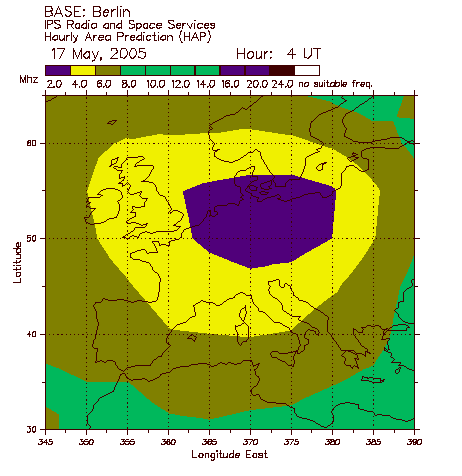
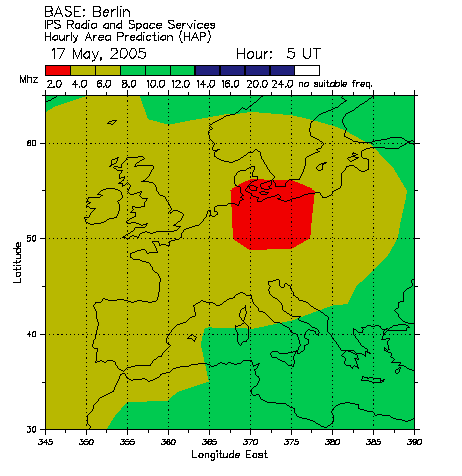
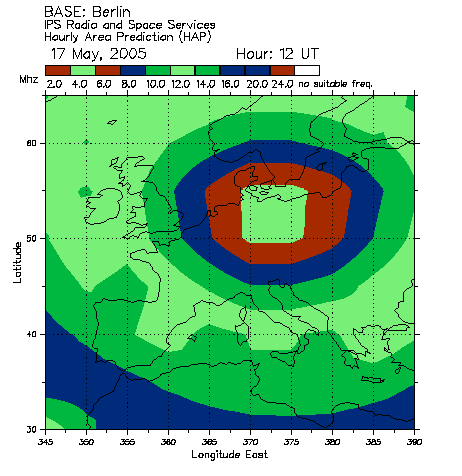
The HAP chart for 1200 UTC shows that, on this day, reception of the 5 day 1130 transmission on Programme 2 would most likely have been received on 11039 kHz in the Gulf of Genoa and the northern half of the Adriatic. Over the southern half of the Mediterranean, 14457.3 kHz would probably have been a better frequency to use. In between, then either might have worked - or might not!
The two charts below are at 1700 UTC on successive days. On the 17th, over a large area, the workable frequencies seem to be about 2 MHz
lower than on the 16th. The chart for the 16th suggests that, for us, in Syracuse, the most likely frequency to receive would be over 16 MHz
. In fact, at 1610 UTC we got reasonable reception on the 10100.8 frequency for most of the broadcast but, at 1735 on 11039 we got poorer reception. The following day, I ran the laptop on its battery, rather than use mains power and a transformer, and got very good reception on 10100.8 kHz!
Moral - think about local causes of interference!!! Try turning off sources of interference. Listen to the signal on the radio. The ear is a very good discriminator.
Predicting radio reception seems to be as difficult as forecasting the weather; after all, it is a matter of predicting stratospheric conditions! This depends both on the earth's atmospheric conditions as well as on solar weather. The latter is another ball game over and above our well known and well understood, if far from perfect, tropospheric prediction.
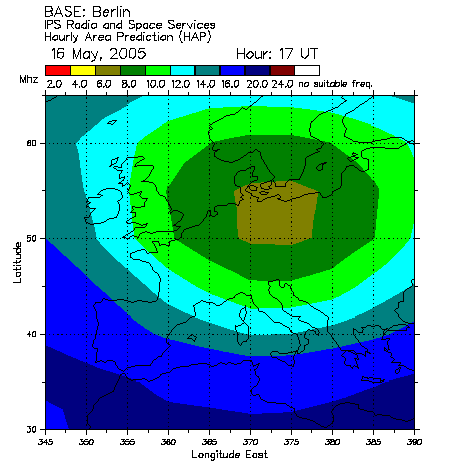
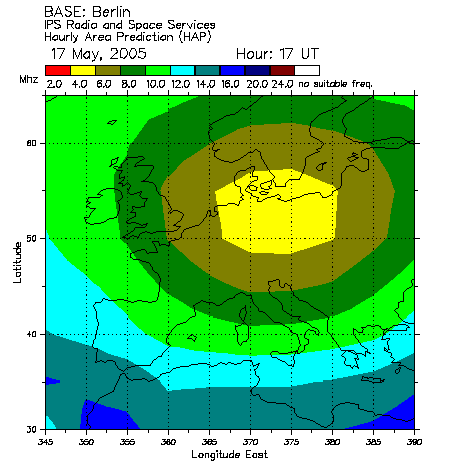
Lessons learnt - Power is not everything
Perhaps one lesson is that it is worthwhile experimenting with the various frequencies available and be prepared to use the Programme 2 in German. Secondly, reception can vary greatly from day to day as a consequence of solar activity, flares and explosions. The HAP charts thus, may or may not give good guidance.
It is all too easy to think that better reception will be obtained by using the 10 kW transmission on 10100.8 kHz. All being absolutely equal, that would be the case. But, life is never simple and rarely is everything absolutely equal.
If not too badly corrupted messages can sometimes be translated - see the hints at the paragraph on garbled messages on the RTTY page.
On occasion, I have compared messages an hour apart on the 10100.8 and 11039 frequencies as well as on the same frequencies a day apart. Poor reception on some and near perfect on others. It all goes to emphasise that one should not generalise on the basis of limited experience. Also, that it is often worth trying the various frequencies
Why I regard HF/SSB services as so important
An alternative to the DWD RTTY, and one that sailors are increasingly using as a matter of preference, is the US GRIB service available from Saildocs and elsewhere. This is a free service obtainable at a very low cost by email, using a GPRS, or even GSM, telephone connection to a laptop. Weather charts can be received, free, on the Internet. Why bother with something so old fashioned and slow as HF/SSB radio?
One answer is that it is useful to have more than one opinion from reputable meteorological sources. The DWD grid point forecasts can be easily compared to GRIB output. Display both side by side on the screen; select a DWD Grid point location on the GRIB forecast chart, place the screen pointer there and read off the values. It becomes quickly obvious if they are similar or not. Very different forecasts imply uncertainty and it may be best not to make too many decisions until the differences are resolved. Caution, as ever where weather is concerned is the name of the game.
Around the UK, using the UK NAVTEX extended 5 day outlook, it will be possible to get some idea of how similar are the UK and DWD forecast models behaviour and how much faith to put in the forecast.
Another, very valid reason for having HF/SSB is for use when out of range of mobile telephone signals. Obviously, this is more likely for long distance sailors than those, like me, who are really on extended, mainly coastal cruises. Some anchorages may be out of Mobile phone range. Internet services are not genuinely operational. RadioFax and RTTY are. It may seem like having belt and braces, but I would not like to have to rely entirely on the Internet, good though it is. HF/SSB plus NAVTEX are, to my mind both useful and necessary at times.
Summary
RTTY reception can be difficult, not only because of solar activity but because of inadequate or poorly installed equipment. Nevertheless, even with budget priced radios, inadequate aerials and other shortcomings, useful information can still be received with a little patience and experimentation. The results have some very real use to help evaluate other forecasts. This is especially so as the DWD Numerical Weather Prediction model is good. My own impressions were that the DWD prediction model performed rather better in the Mediterranean than the US model. That may have changed now.
HF/SSB is also a source of spoken forecasts and, when away from home, can also be used for the BBC World Service. On the basis of a difficult Summer it would be premature to throw away the old and well tried, if old fashioned, technology in favour of newer services such as the Saildocs GRIB coded forecasts good though these are. Sailors should always be prepared to use and compare forecasts from different sources and successive forecasts from the same source.
Acknowledgement
Yet again, I have tried the patience of Ross Biddle, skipper of Gemini. Yet again, he has tried to educate me in the matter of radio propagation. Whether he has had any success is for the reader to decide!
